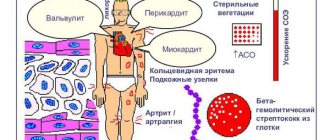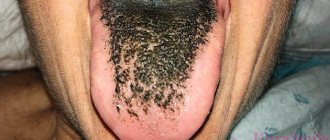Warts are classified as benign neoplasms.
They can appear on various parts of the skin and mucous membranes.
If a wart appears on the lip, it represents a cosmetic defect and can also cause discomfort to its owner, worsening the quality of life.
Forming on the lip, the tumor affects speech and interferes with eating.
A wart can cause pain, especially if it is localized on the mucous membrane inside the lip.
If measures are not taken to eliminate it, the growth may become injured, which will lead to a secondary infection.
Types of warts
A wart is a growth that rises above the surface of the skin or mucous membrane.
Its dimensions, as a rule, are no more than 1 centimeter in diameter.
The tumor can appear on any part of the body, including the face.
On the face, most often a wart forms on the lip, above or below the lip, on the buccal surface of the oral mucosa.
A warty growth can appear on both the upper and lower lips.
The following types of neoplasms are distinguished:
- Common (vulgar) warts. These are growths that have a dense structure, soft to the touch, flesh-colored or yellowish in color. New growths form on the red border of the lips. They are not painful, but tend to itch. Vulgar warts appear on the lips not only in adults, but also in children.
- Flat- shaped growths may appear on the outside of the lips or on the oral mucosa. Their surface is smooth, oval or round in shape. The color of the growth resembles the color of the skin and almost does not rise above it. The location is also the red border of the lips. Flat warts do not hurt, but they are very itchy.
- Hanging neoplasms are located on a thin stalk. At the beginning of development they resemble a bump. They have a brown, pinkish tint or close to the color of the skin.
- Filiform (acrochords). These are small growths that appear after 35 years, but can occur earlier.
- Genital warts . The localization of such growths is the mucous membrane. The new growths are elongated and arranged in groups, resembling a cockscomb or cauliflower inflorescences. The growths are prone to injury, which causes inflammation and bleeding.
The wart forms gradually and almost imperceptibly.
- At the beginning of development, a small compaction forms, which gradually increases.
- A white dot forms on the surface of the mucous membrane of the lip or in the mouth, which gradually turns into genital warts.
To date, approximately one hundred types of papillomavirus have been discovered.
Some types of growths have a benign course, while others are capable of malignancy.
They can provoke the development of cancer.
In addition to the types of growths listed above, there are also senile warts (keratoma, keratosis).
The difference between keratosis is that its appearance is not associated with papillomavirus, and keratoma does not provoke the formation of cancer.
In their development, senile warts go through several stages:
- ✓ brown spots appear, but the wart has not yet formed
- ✓ formation of papules and nodules
- ✓ appearance of keratoma - when you try to scrape off the scales, bleeding appears
- ✓ transition to the cutaneous horn, which is characterized by excessive growth and keratinization of the neoplasm
According to some experts, keratosis and senile warts belong to different diseases.
Symptoms
If there are papillomas in intimate places, symptoms are divided into subjective (sensations, complaints) and objective (which can be directly seen by a specialist). Subjective ones include:
- the presence of growths (single or multiple);
- spots on the skin and mucous membranes of the genital organs;
- itching and other unpleasant superficial sensations in the affected area;
- pain during sexual intercourse;
- if male papillomas in intimate places are located in the urethra, burning and painful itching and difficulty urinating may be observed.
The pathology is characterized by the presence of painful cracks and bleeding of the skin and mucous membranes.
Objective symptoms include:
- rashes;
- papules and spots;
- wart-like papillomas;
- pointed condylomas localized in the perineum and perianal area.
The difference between a wart and keratoses and cancer
Keratosis may be similar in appearance to melanoma (a type of skin cancer).
Melanoma can begin as a warty growth or as a seborrheic keratosis.
A dermatologist can distinguish them from cancer.
To exclude an oncological process, a biopsy is performed.
The peculiarity of seborrheic keratosis is that the formation is waxy, flat, and there is no pain when touched or at rest.
With cancer, a growth similar to a keratosis may change shape or color.
In this case, you will need to consult a specialist.
Doctors' opinions on the most effective methods of treating warts and papillomas
The chief physician of Moscow City Hospital No. 62 describes his vision on this matter. Anatoly Nakhimovich Makhson Medical practice: more than 40 years.
“I have been treating people’s papillomas and warts for many years. I’m telling you as a doctor, papillomas along with HPV and warts can really lead to serious consequences if they are not dealt with.
The human papillomavirus is present in everyone on whose body there are papillomas, moles, warts and other pigmented formations. According to rough estimates, 80-85% of the planet's population has it. By themselves they are not dangerous. The problem is that an ordinary papilloma can become melanoma at any time.
These are incurable malignant tumors that kill a person in just a few months and from which there is no salvation.
Unfortunately, in Russia and the CIS countries, pharmaceutical corporations sell expensive medications that only relieve symptoms, thereby hooking people on one drug or another. That is why in these countries there is such a high percentage of cancer diseases and so many people suffer from “non-working” drugs.
The only drug that I want to recommend, and it is also officially recommended by WHO for the treatment of papillomas and warts, is Papinol. This drug is the only remedy that has an effect not only on external factors (that is, it removes papillomas), but also acts on the virus itself. At the moment, the manufacturer has managed not only to create a highly effective product, but also to make it accessible to everyone. In addition, within the framework of the federal program, every resident of the Russian Federation and the CIS can receive it for 149 rubles.”
To find out more, read this article.
Causes of warts
The appearance of warts is caused by infection with papillomavirus or HPV.
Since the skin on the lips is quite thin, it is therefore easily permeable to viruses.
It should be noted that signs of infection with the human papillomavirus do not always occur.
The better the immune system, the less likely it is that symptoms of the disease will appear.
And yet, most of the world's population is infected with HPV.
The incubation period for the development of the disease can be several months or years.
As soon as the immune system fails, the first signs of infection appear.
Activation of the virus is accompanied by the formation of warts.
As a rule, growths appear on the area of the skin or mucous membrane where the pathogen entered the body.
Infection can occur both through sexual contact and through household contact.
Can the virus be transmitted by kissing on the lips?
The most common cases of infection are:
- intrauterine infection of the fetus if a pregnant woman is infected with papillomavirus
- shaking hands or kissing an infected person (if there are wounds or abrasions, the risk of infection increases)
- the use of personal items of an infected person (toothbrush, dishes, lipstick) is unlikely, since the pathogen is not stable in the environment
- sex accompanied by oral sex
- visiting common areas (swimming pool, sauna, shower)
People at risk are those who:
- patients with diabetes mellitus or other pathology of the endocrine system
- suffer from obesity and metabolic disorders
- taking antibiotics for a long time
- have chronic diseases
- suffer from increased sweating, especially on the feet, as this is where plantar warts often form
A malfunction of the immune system can occur for the following reasons:
- If there is a deficiency of essential substances in the body
- After suffering stress or physical exhaustion
- In case of hormone imbalance: during puberty, during pregnancy, with the onset of menopause, during treatment with hormonal drugs
- In case of chronic lack of sleep and overwork
- Due to a recent infectious disease
- If a person abuses smoking and alcoholic beverages
Papilloma on the lip, what is it?
The appearance of papilloma on the lip may indicate the presence of human papillomavirus in the body. A benign neoplasm can spoil the appearance and cause psycho-emotional distress.
In appearance, the human papillomavirus on the lips is presented as a small growth on a flesh-colored stalk. The main places where tumors accumulate are observed at the corners of the mouth. The height and width of the papilloma can reach 2 mm. Protracted forms of the disease may look like large papillomas, in which the upper keratinized layer reaches up to 2 cm.
Medicine is confident that in most cases the neoplasm is benign. However, ignoring treatment can lead to the degeneration of the growth into a malignant tumor. To prevent such developments, you need to have knowledge about the causes of the virus indicated in our article, and also know which doctor to turn to for help.
Often, under the guise of HPV, a malignant neoplasm can develop, developing from an injured mole.
The following signs indicate malignant degeneration of papilloma on the lips:
- ulcerative irregular form of neoplasm;
- heterogeneity of texture;
- separation of liquid contents with blood particles;
- hair loss (if any);
- growth of the tumor far beyond the lip area.
Regardless of the type of symptoms, if you suspect HPV in the form of papillomas on the lips, it is recommended to consult a doctor for help. Such doctors are: family therapist, infectious disease specialist, dermatologist and oncologist.
Diagnosis of warts
The main diagnostic method is to examine the patient's face for the presence of warts on the lips and oral mucosa.
To confirm or refute the presence of HPV, it is enough to take tests:
- ✓ Blood tests for antibodies
- ✓ To conduct a histological examination (biopsy), a small part of the tumor is taken for analysis
- ✓ The PCR technique allows you to detect the genetic material of a pathogen with one hundred percent probability
Before getting rid of the growth, you should visit an oncologist.
A specialist will use dermatoscopy to determine the condition of the wart to rule out signs of malignancy.
Clinical manifestations of warts on the lip
A wart on the lip does not appear the next day after the papilloma virus enters the body.
The incubation period can last from six months to several years.
This often occurs when the immune system malfunctions.
Having penetrated the skin or mucous membrane, the virus integrates its genetic material into human cells and thus begins to multiply.
As a result, characteristic neoplasms appear at the site of virus introduction.
The pathogen provokes warty growths, disrupting the processes of keratinization of the skin.
Oncogenic strains of papillomavirus change the genetic apparatus of cells in such a way that a malignant formation is formed.
Removal
Once the benign quality of the formation is determined, it is recommended to get rid of it to prevent possible complications in the future and a good cosmetic result. Regardless of the method chosen, a number of rules are of great importance:
- If the approach does not involve immediate removal, then it is forbidden to remove what is left - the crust should fall off on its own. Otherwise, there is a risk of infection and the formation of an unsightly scar.
- After the procedure, you should avoid prolonged exposure to the sun: the lip should be protected from ultraviolet radiation.
- Having removed the manifestations of HPV on the lips, you should stop using lipstick until complete healing.
Is it necessary to remove a wart on the lip?
Removal of the tumor is carried out if there are indications for this.
The growths sometimes disappear spontaneously.
Therefore, if the wart is small and does not cause much concern, then there is no need for removal.
The decision to excise the growth must be made by a specialist.
If a wart causes discomfort in the form of itching, burning, pain, grows, becomes inflamed, or changes in appearance.
If it has increased in size, changed shape and color, or is bleeding, then it must be removed by resorting to excision by one of the methods.
Removing a tumor at home is not safe.
As a result of incorrect actions:
- It may not be possible to remove the wart completely, which will cause its reappearance
- the risk of injury to healthy tissues that surround the growth increases
- scars and cicatrices may form
Wart treatment
Treatment of any growth on the lips begins with a medical examination and determining whether the growth is malignant.
Next, the doctor selects a method of therapy.
In case of a malignant form, the patient is referred to an oncologist, who will decide how to treat the patient.
Treatment of the disease is complex.
Treatment consists of the main stages: removal of the growth and drug therapy.
Removal of the tumor can be done in one of the following ways:
- ✓ Using pharmaceutical products
- ✓ In a medical institution where modern excision techniques will be used
- ✓ Folk remedies. The use of alternative medicine methods must be agreed with a doctor
be careful
The presence of papillomas and warts on the body is the first sign of malignant melanoma!
We hasten to warn you that most drugs that “treat” warts and papillomas are a complete deception of marketers who make hundreds of percentage points on drugs whose effectiveness is zero. They do not cure the disease, but only mask the symptoms.
The pharmacy mafia makes huge money by deceiving sick people.
But what to do? How to treat if there is deception everywhere? Doctor of Medical Sciences Anatoly Makhson conducted his own investigation and found a way out of this situation. In this article, the Doctor also told how to 100% protect yourself from melanoma, for only 149 rubles! Read the article in the official source via the link.
Summary
The appearance of neoplasms on the outer and inner sides of the lips brings discomfort to a person when communicating with people and eating food. The disease worsens the quality of life and lowers self-esteem. Refusal to treat unpleasant growths leads to their spreading to other parts of the body, which affects the appearance.
Cases of neoplasms degenerating into malignant tumors have become frequent. To prevent this from happening, you must promptly seek help from a doctor. Drug treatment in combination with traditional methods can speed up the healing process. The last resort for getting rid of papillomas is surgery. Be healthy and don't get sick.
We invite you to watch a video of how a papilloma on the mucous membrane of the lower lip is removed. Do not watch if you are sensitive, as surgical intervention is indicated.
Pharmacy products for removing warts
You can buy medications at the pharmacy that will help you deal with warts at home.
Among them:
- Super clean . The product is an alkaline solution that has a chemical effect on the growth, causing cauterization.
- Cryopharma, Wartner . These agents cause cryodestruction of the wart; as a result of cold exposure, the neoplasm is frozen.
- Solcoderm . A drug containing acids that have a cauterizing and mummifying effect on pathological tissues.
- Immunomodulators – Viferon, Oxolinic ointment will help increase immunity and the body’s fight against the virus.
- Antiviral agents – Isoprinosine, Interferon.
The use of cauterizing agents on the lips and face is extremely undesirable; application of these agents to the oral mucosa is especially dangerous.
Wart removal in the clinic
The clinic uses modern hardware techniques to excise growths:
- Laser therapy . The method allows you to quickly and without blood remove the growth. There is no discomfort during the procedure, as pain relief is performed. During one session, you can get rid of several tumors in a very short time. The method is suitable not only for adults, but also for children. The likelihood of relapse is minimized. Skin defects in the form of scars after laser use are very rare.
- Radio wave therapy . The technique is considered the safest. When excising a wart using a radio wave, there is no contact with the skin. It is not always possible to completely remove the growth. The procedure leaves no traces of impact.
- Electrocoagulation . The procedure requires anesthesia. Using an electrode to which a high-frequency electric current is applied, the wart is burned out, followed by cutting off the growth with a special metal loop. Scarring may appear after removal.
- Cryodestruction . Liquid nitrogen is used and the wart is treated until it turns white. As a result of exposure to low temperatures, the growth tissues die. There is no need for anesthesia for the manipulation. The disadvantage of the technique is the lack of control over the depth of nitrogen exposure. For this reason, frequent relapses occur.
- Surgical. Removal is done using a scalpel. The disadvantage of the procedure is the formation of a scar, so this technique is used only for certain indications (in case of malignancy of the process and large size of the wart).






